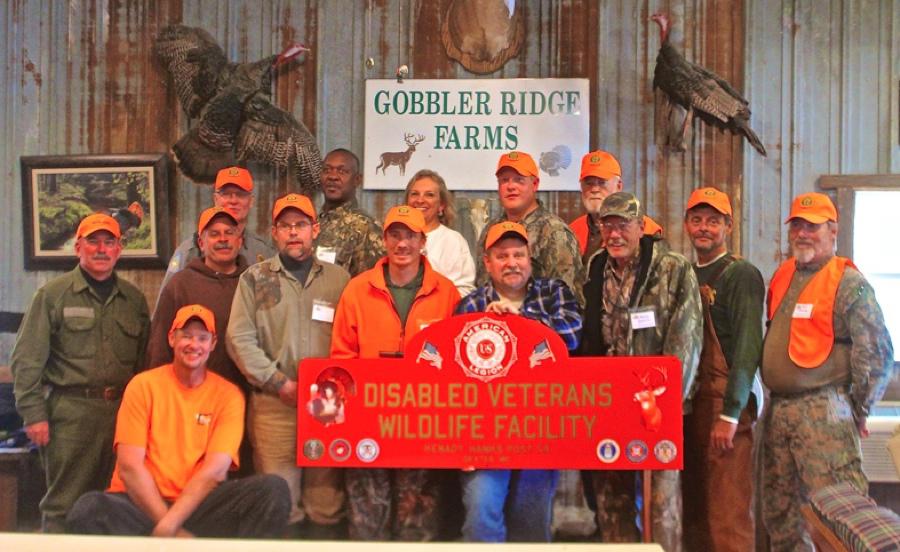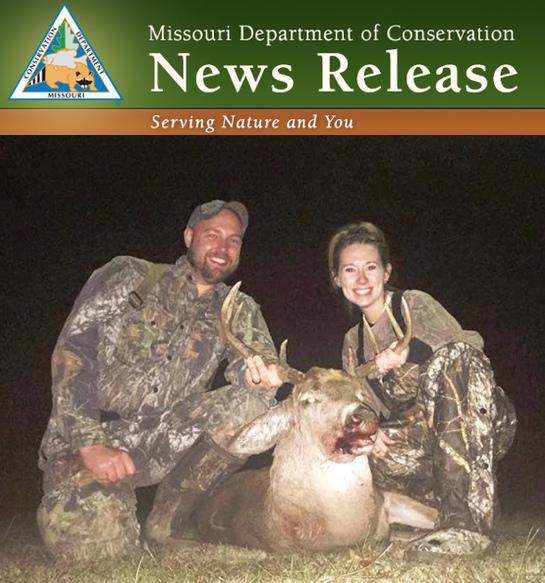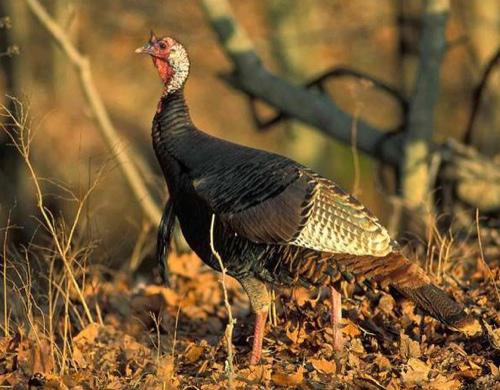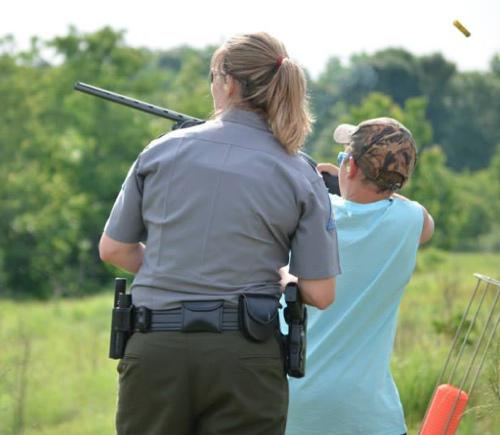
Wildlife Facility.
 The 125-acre farm, located west of Bloomfield, was offered to six area disabled veterans on Tuesday for a day of deer hunting in some prime Stoddard County wilderness.
The 125-acre farm, located west of Bloomfield, was offered to six area disabled veterans on Tuesday for a day of deer hunting in some prime Stoddard County wilderness.Gobbler Ridge Farm, owned by Tom Love and Alan Hedrick, was transformed into a haven for disabled veterans in 2012 through a no-cost lease agreement with its owners and the American Legion Post #59 in Dexter.
Legion members manage the facility, which includes a spacious, handicap equipped cabin, and the facility operates through generous community donations and a host of volunteers.
Along with Tom Love and members of Post 59, making the hunt possible were several members of the Missouri Department of Conservation, the Sikeston Rotary Club, Jerry Elder with Zalma Frozen Foods and members of the National Wild Turkey Federation.
The six veterans ended their day with a total of three deer killed. The group enjoyed lunch in the cabin on the farm and a tour of the grounds.
The Disabled Veterans Wildlife Facility is available to all disabled veterans in the area, regardless of whether the disability is a direct result of their service.
Contact Tom Love at (573) 820-0802 for further information. The farm is available for hunting, fishing, or simply enjoying the abundant wildlife on the farm.
Veterans included in the hunt were Chris Hyche, Tony LaForest, Mike Cord, Matt Johnston, Wayne Godwin and Tony Curran

Harvest up from 2014 by 5,700+.
Missouri - Preliminary data from the Missouri Department of Conservation (MDC) shows that deer hunters in Missouri harvested 97,171 deer during the opening weekend of the November portion of fall firearms deer season, Nov. 14 and 15. Of the 97,171 deer harvested, 53,359 were antlered bucks, 10,320 were button bucks, and 33,492 were does.
Top harvest counties for opening weekend were Texas County with 2,184 deer checked, Howell County with 1,959 and Franklin County with 1,899.
Last year, hunters checked 91,460 deer during the opening weekend of the 2014 November Portion of Firearms Deer Season.
The November portion of the fall firearms deer season continues through Nov. 24. Archery deer hunting opens again from Nov. 25 through Jan. 15, 2016. The firearms antlerless portion will run Nov. 25 through Dec. 6. The firearms alternative methods portion will run Dec. 19-29 followed by the firearms late youth portion Jan. 2-3, 2016. Missouri's early youth weekend ran Oct. 31 and Nov. 1. The firearms deer urban zone portion ran Oct. 9 – 12.
Missouri offers some of the best deer hunting in the country and deer hunting is an important part of many Missourians' lives and family traditions. Deer hunting is also an important economic driver in Missouri and gives a $1 billion annual boost to the state and local economies.
Shown in the photo are Ben and Melissa Stevens of Dexter, Missouri.

The Missouri Department of Conservation (MDC) announced that hunters checked 6,158 turkeys during Missouri's fall firearms turkey season, which ran Oct. 1 - 31. Last year's fall firearms turkey harvest total was 5,680. Top harvest counties for the 2015 fall firearms turkey season were Dent with 210, Greene with 159, and Franklin with 148.
Fall archery turkey hunting continues until Nov. 13 and then resumes again from Nov. 25 through Jan. 15, 2016.
For fall firearms turkey harvest results by county and type of bird, go online to the MDC website at extra.mdc.mo.gov/widgets/harvest_table/.

DUCK SEASONS
North Zone: Oct. 31 – Dec. 29
Middle Zone: Nov. 7 – Jan. 5
South Zone: Nov. 26 – Jan. 24
Shooting Hours: One-half hour before sunrise to sunset.
Daily Bag Limit: Six ducks daily with species restrictions of:
4 mallards (no more than 2 females)
3 scaup
3 wood ducks
2 redheads
2 hooded mergansers
2 pintails
2 canvasback (increased from 1 last year)
1 black duck
1 mottled duck
Possession Limit: Three times the daily bag limit (18), including species restrictions.
COOT SEASONS:
Concurrent with duck seasons in the respective zones with a daily bag limit of 15 and a possession limit of 45.
GOOSE SEASONS:
Light geese: snow, blue, and Ross’s: Statewide, Oct. 31 - Jan. 31
White-fronted geese: Statewide Nov. 7 - Jan. 31
Canada geese and brant: Statewide Oct. 3 - Oct. 11 and Nov. 26 - Jan. 31
Shooting Hours: One-half hour before sunrise to sunset.
Daily Bag Limit and Possession Limit: No more than three Canada geese and brant geese in aggregate daily and nine in possession, 20 light geese (snow, blue, or Ross’s) daily with no possession limit, and two white-fronted geese daily and six in possession.
YOUTH HUNTING DAYS:
North Zone: Oct. 24 and 25
Middle Zone: Oct. 31 and Nov. 1
South Zone: Nov. 21 and 22
Bag Limit: Same as during regular waterfowl season.
Shooting Hours: Same as during regular waterfowl season.
Participation Requirements: Any person 15 years of age or younger may participate in the youth waterfowl hunting days without permit, provided they are in the immediate presence of an adult 18 years of age or older. If the youth hunter does not have hunter-education certification, the adult must meet permit requirements for small-game hunting and have in his or her possession valid hunter-education certification unless born before Jan. 1, 1967. The adult may not hunt ducks, but may participate in other seasons open on the youth days.
LIGHT GOOSE CONSERVATION ORDER:
The Conservation Order for light geese will be in effect Feb. 1 through April 30 with no bag limit. Hunters may use electronic calls and unplugged shot guns. Shooting hours are from one-half hour before sunrises to one-half hour after sunset. A Conservation Order permit is the only permit required for resident and nonresident hunters.
FALCONRY SEASON FOR DUCKS, COOTS AND MERGANSERS:
The federal framework allows 107 days. Falconry is open during teal season (16 days), regular duck season (60 days), and youth season (two days) in the respective zones, leaving Feb. 11 – March 10 (29 days) for extended falconry statewide.
Hunting Hours: One-half hour before sunrise to sunset.
Bag and Possession Limits: The daily bag and possession limits shall not exceed three and nine birds, respectively, singly, or in the aggregate, during the teal, regular duck, youth waterfowl and extended falconry seasons.
TEAL SEASONS:
As previously announced by MDC in July, blue-winged, green-winged, and cinnamon teal may be taken from Sept 12 through Sept. 27 from sunrise to sunset with a combined daily limit of six and a combined possession limit of 18 for all three species. Additional details are published in MDC's 2015 Migratory Bird Hunting Digest available where hunting permits are sold, at MDC offices and nature centers, and online at mdc.mo.gov.
WATERFOWL POPULATION ESTIMATES:
According to the U.S. Fish and Wildlife Service, the total number of North American ducks is estimated to be at a record high for the fourth year in a row at 49.5 million, 43% above the long-term average (LTA). Estimates of breeding populations for various duck species from 2015 survey results are:
Mallard numbers are similar to the 2014 estimate and 42 percent above their long-term average.
Blue-winged teal numbers are similar to 2014 and 73 percent above their long-term average.
Green-winged teal numbers increased by 19 percent, which puts them 98 percent above their long-term average.
Northern shoveler numbers dropped by 17 percent but still remain 75 percent above their long-term average.
Gadwall and American wigeon numbers are similar to 2014 and 100 and 17 percent above their long-term averages, respectively.
Redhead numbers are similar to 2014 and 71 percent above their long-term average.
Canvasback numbers increased slightly. They are now estimated to be 30 percent above their long-term average.
Scaup numbers are similar to the 2014 estimate and 13 percent below their long-term average.
Pintail numbers are similar to 2014 and 24 percent below their long-term average.
HUNTING OUTLOOK:
MDC Resource Scientists note that there are three factors equally or more important than overall population numbers in contributing toward a season’s outcome: local habitat conditions, weather, and migration timing. They caution that preseason outlooks for habitat and weather are less than ideal.
“Wetlands should have plenty of water going into fall, but extensive and repeated flooding over the summer will mean food and cover could be patchy,” explained MDC Resource Scientist Andy Raedeke. “Moist-soil seed production will be excellent in wetlands that benefitted from a wet spring and early summer but did not have late-summer flooding. Those that did experience late flooding will likely have poor moist-soil seed production and limited vegetation for cover. Due to flooding, food provided by crops, such as corn, will likely be well below average.”
Raedeke added that weather conditions play a significant role in affecting duck movements and distribution. “Long-term weather forecasts are calling for milder than normal fall and winter weather in the upper Midwest,” he said.
Habitat conditions and weather combine to influence waterfowl migrations.
“The primary uncertainty is how ducks will respond if we have a hunting season with mild weather, plenty of water, and below average food and cover,” said Raedeke. “In the absence of significant cold fronts, ducks may disperse throughout the Mississippi Flyway resulting in lower peak numbers in Missouri. Once ducks arrive in Missouri, habitat conditions will influence how long they stay. Species that depend entirely on wetland sources of food may depart sooner than normal. For species that also field feed, such as mallards, the combination of ample water for roosting and harvested grain fields for feeding may help offset effects of below average wetland conditions.”
He added that hunters will need to be flexible in when and where they hunt. “If it is a mild fall, it will be especially important to time hunts with cold fronts and migration events. Hunters should also be willing to try new locations for potentially better habitat conditions,” Raedeke said.
Photo by Jimmy Sisk of Charleston, Missouri.

by Dee Dee Dockins
Stoddard County, Missouri - As an Outdoor Skills Specialist, one of the questions most asked is how to start kids out hunting. Easy, focus on your child. As simple as it may seem, most parents think that if they don’t harvest an animal, their child won’t enjoy the hunt. Hunting with mom or dad in the field and having fun is your ultimate goal.
Keeping focused on the total hunting “experience” will help ensure a successful hunt with your child. The first key to starting kids out hunting is to build interest and anticipation prior to heading to the field. Parents who skip this step are doomed from the start. One of my favorite experiences with my son is scouting for deer or turkey. He finds the signs of animals and then helps decide where to set our blind. We then set up the blind and watch for game before opening day. Sometimes that lasts 10 minutes and sometimes 2 hours, it depends on his attention span. You could also cook a wild game dinner with your child to help them form the connection between the hunter and the harvest.
Any successful hunter will plan their trip prior to the hunt. Well laid plans ensure that each step of the experience will be positive and spark interest in the hunt. Allowing your child to help make plans for the hunt gives him or her ownership in the experience.
Here are few more pointers:
1. Make sure your children are comfortable, dressed in layers. You can purchase rain gear but keep in mind that your child probably doesn’t want to hunt in the rain.
2. Leave your firearm at home. Concentrate on your child during the hunt. The only thing you should shoot during their hunt is a camera. YOU can hunt another day.
3. Take your child hunting as soon as he or she can quietly sit in the blind. They don’t have to have a firearm to hunt.
4. If they are going to shoot, find a firearm that fits them and can be shot comfortably, no exceptions.
5. Teach conservation all the time. Make certain your child understands why you’re planning to hunt in a certain location and the importance of good habitat. Ask them to tell you why this is a good place to hunt and continue the education while waiting in the blind.
6. Practice what you preach. Demonstrate safe, responsible and ethical behavior at all times. Your children will mimic your behavior.
7. Bring a set of binoculars for your child. One of the easiest ways to keep a child occupied is the use of binoculars.
8. Ground blinds are very forgiving. These blinds can hide most all movements of fidgety hunters and even provide an area to sleep during those slow morning hunts.
9. Keep the hunt short. When they are ready to go home, GO HOME. Remember, you are hunting for them. If you hunt for 10 minutes today but 20 minutes tomorrow you are still making an improvement.
If you build the experience step by step you will be rewarded tenfold. Continued congratulations on successes and positive encouragement about missed opportunities lift spirits.
Compliments about his or her shooting abilities, keen eye, ability to identify animals, etc. will be imprinted on their brain forever. Make sure your child knows how much fun it was being with them afield—that’s the trophy.
The countless hours you and your child spend afield creates memories that bond one generation to another. Regardless of how many hunting videos you both watch, how many other hunters he talks to, the child will look to up to you the rest of their life. You will be the one who EXPERIENCED the each step of this grand adventure with them. You will be the one who taught them the joy of hunting.

